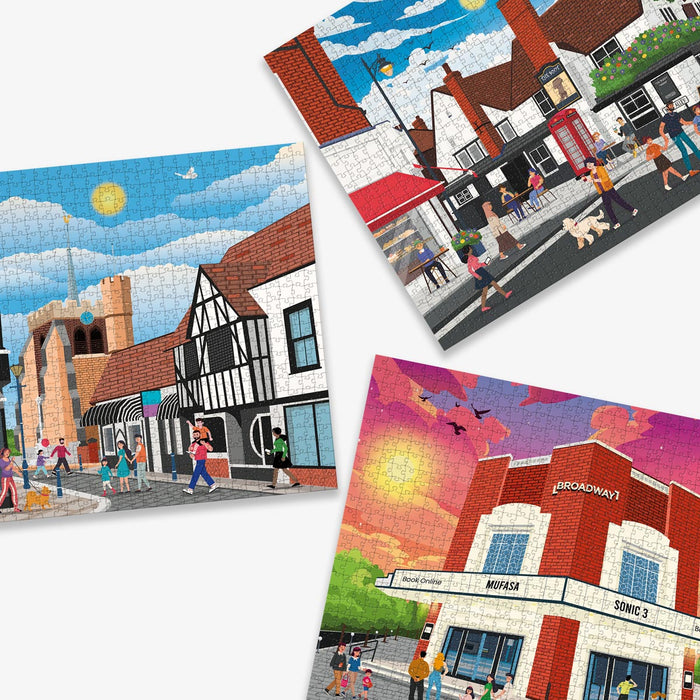Introduction
In today's fast-paced digital age, where screens dominate our daily lives, traditional toys and activities like jigsaw puzzles might seem like relics of the past. However, these seemingly simple puzzles offer a plethora of educational benefits for children that are worth exploring and promoting. In this article, we'll delve into the significance of puzzles in children's learning and development, shedding light on their cognitive, motor, and social-emotional benefits.
The Cognitive Benefits of Puzzles for Children
The benefits of jigsaw puzzles are more than just fun games; they are powerful tools for nurturing cognitive skills in children. When children engage in puzzle-solving activities, they are required to use their brains in various ways, such as problem-solving, spatial reasoning, and logical thinking. For instance, when a child examines the pieces of a jigsaw puzzle, they must identify patterns, shapes, and colours to determine where each piece fits within the larger picture. This process enhances their spatial awareness and visual perception, laying the groundwork for mathematical and scientific thinking later in life.
In the history of jigsaw puzzles there have been many research studies have consistently demonstrated the cognitive benefits of puzzle-solving in children. A study published in the "Journal of Educational Psychology" found that children who regularly engaged in puzzle-solving activities exhibited higher levels of spatial reasoning and problem-solving abilities compared to their peers who did not participate in such activities. This suggests that puzzles play a crucial role in developing children's cognitive skills and preparing them for academic success.
Moreover, puzzles provide children with opportunities to exercise their critical thinking and analytical skills. As they analyse the shapes and sizes of puzzle pieces, children learn to make logical deductions and infer relationships between objects. This process encourages them to think critically, evaluate evidence, and draw conclusions—an essential skill set for navigating the complexities of the modern world.

The Motor Skills Development Through Puzzles
In addition to enhancing cognitive abilities, puzzles also play a vital role in the development of fine motor skills, hand-eye coordination, and dexterity in children. When children manipulate puzzle pieces with their hands, they engage in a range of fine motor movements, such as grasping, pinching, and rotating. These movements strengthen the muscles in their hands and fingers, improving their manual dexterity and control.
Fine motor skills are crucial for performing everyday tasks such as writing, drawing, and tying shoelaces. By engaging in puzzle-solving activities, children develop the coordination and precision necessary for these activities, setting the stage for academic readiness and independence.
Furthermore, puzzles offer children sensory experiences that stimulate their tactile and proprioceptive senses. As they feel the texture of puzzle pieces and manipulate them to fit together, children receive valuable sensory feedback that helps them understand spatial relationships and object manipulation. This sensory input contributes to the development of body awareness and spatial orientation, which are essential components of overall motor development.
The Social-Emotional Benefits of Puzzles
Beyond their cognitive and motor benefits, puzzles also provide valuable opportunities for social-emotional growth in children. Puzzle-solving encourages qualities such as patience, perseverance, and resilience—the ability to persist in the face of challenges and setbacks. As children encounter difficulties and obstacles while working on a puzzle, they learn to approach problems with a positive attitude and tenacity, building their resilience and confidence.
Moreover, puzzles promote social interaction and collaboration among peers. When children work on puzzles together, they must communicate effectively, share ideas, and negotiate solutions—a process that fosters teamwork and cooperation. By collaborating with others to achieve a common goal, children learn valuable interpersonal skills such as empathy, respect, and compromise, which are essential for building healthy relationships and navigating social situations.
In addition, puzzle-solving can boost children's self-confidence and sense of accomplishment. As they successfully complete a puzzle, children experience a sense of pride and satisfaction in their achievements, reinforcing their belief in their abilities and boosting their self-esteem. This sense of accomplishment motivates children to tackle new challenges with confidence and enthusiasm, fostering a growth mindset and a love for learning.
Age-Appropriate Puzzle Recommendations
Puzzles come in various shapes, sizes, and complexities, making it essential to choose ones that are suitable for children's developmental stages. Here are some age-appropriate puzzle recommendations along with guidelines for selecting puzzles with the right piece count and complexity for different age groups.
For toddlers and preschoolers (ages 1-4), opt for large, chunky puzzles with simple shapes and bright colors. Wooden or foam puzzles with knobs for easy gripping are ideal for this age group. Look for puzzles that feature familiar objects or animals to engage young children's curiosity and promote language development.

As children enter the preschool and early elementary years (ages 4-7), they can handle more complex puzzles with smaller pieces. Choose puzzles with 20-50 pieces that challenge children's problem-solving skills without overwhelming them. Look for puzzles that depict scenes from everyday life or popular children's characters to capture their interest and spark their imagination.
For older children (ages 8 and up), consider puzzles with 100 pieces or more that offer a greater level of challenge and complexity. Look for puzzles with intricate designs or themes that align with children's interests and hobbies, such as sports, nature, or outer space. Encourage children to tackle puzzles independently or collaborate with friends and family members to complete larger puzzles together.
When selecting puzzles for children, consider their age, developmental level, and individual preferences. Start with puzzles that have fewer pieces and simpler designs, gradually increasing the piece count and complexity as children develop their puzzle-solving skills. Pay attention to the recommended age range and difficulty level indicated on the puzzle packaging to ensure a suitable challenge for children.
For toddlers and preschoolers, choose puzzles with large, sturdy pieces that are easy to manipulate and fit together. Avoid puzzles with small or intricate pieces that may pose a choking hazard or frustrate young children. Instead, opt for puzzles with colorful images and chunky pieces that encourage hands-on exploration and problem-solving.
As children grow older and their puzzle-solving abilities improve, introduce puzzles with more pieces and intricate designs that require greater concentration and attention to detail. Challenge children to tackle puzzles that push their boundaries and encourage them to think creatively and critically. Encourage children to experiment with different puzzle formats, such as 3D puzzles or puzzle cubes, to expand their problem-solving skills and spatial reasoning abilities.
Popular Themes and Designs in Children's Puzzles
Puzzles come in a wide variety of themes and designs, catering to children's diverse interests and preferences. Here are some popular puzzle themes and designs that appeal to children at different developmental stages:
-
Animals: Puzzles featuring animals are perennial favorites among children of all ages. From farm animals to jungle creatures to dinosaurs, animal-themed puzzles capture children's fascination with the natural world and encourage them to learn about different species and habitats.
-
Vehicles: Puzzles depicting cars, trucks, trains, and other modes of transportation are a hit with young children who love things that go. These puzzles allow children to explore different types of vehicles and learn about how they work while honing their problem-solving skills.
-
Fantasy Worlds: Puzzles featuring fantasy worlds, fairy tales, and mythical creatures ignite children's imaginations and transport them to magical realms full of adventure and wonder. These puzzles encourage children to engage in imaginative play and storytelling as they piece together scenes from their favorite stories and legends.
-
Outer Space: Puzzles showcasing the mysteries of outer space, including planets, stars, and galaxies, inspire curiosity and fascination in children who are fascinated by the cosmos. These puzzles provide opportunities for children to learn about astronomy and space exploration while developing their spatial awareness and problem-solving skills.
Conclusion
In conclusion, puzzles offer a wealth of educational benefits for children, including cognitive, motor, and social-emotional development. By engaging in puzzle-solving activities, children enhance their critical thinking, problem-solving, and fine motor skills while fostering patience, perseverance, and teamwork. Incorporating puzzles into children's play and learning experiences can enrich their development and ignite their curiosity and creativity.
Parents, educators, and caregivers play a crucial role in providing children with a variety of age-appropriate puzzles that support their development and nurture their interests and abilities. By selecting puzzles that align with children's developmental stages and individual preferences, adults can create meaningful learning experiences that inspire children to explore, discover, and grow.
So, whether it's a simple wooden puzzle for a toddler or a challenging jigsaw puzzle for an older child, puzzles offer endless opportunities for learning, discovery, and fun. Let's encourage children to embrace the joys of puzzle-solving and unleash their potential to learn and grow.



